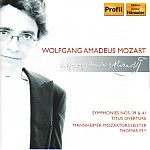Boy, is this vile! Thomas Fey, who has done some marvelous work in Haydn and Beethoven, seems to regard Mozart as a sort of musical blank slate on which to smear all kinds of interpretive graffiti. The need to do something different at all costs bears a strange resemblance to Simon Rattle’s recent, ghastly Schubert Ninth, with virtually every interpretive “idea” being a bad one. In particular, these performances might stand as living testimony to the Seven Deadly Sins of Mannered, Micromanaged, Period-Instrument-Style Conducting. For the record, these are:
1. Vibratoless strings that whimper and whine rather than play. Check out the way they squeeze the opening of the “Jupiter” Symphony, or the same work’s slow movement.
2. A foolish emphasis on repeats that, for example, stretches the first movement of the “Jupiter” to 13 minutes.
3. Vulgar horns, trumpets, and timpani. This can be quite exciting, but not here, when they (for example) obliterate the melody in Symphony No. 39’s minuet.
4. Poor internal balances. Never mind brass and percussion. Why is it that you hear about 10 times more woodwind detail in the finale of Symphony No. 39 from the likes of Klemperer than you do with Fey?
5. Weird and capricious choices of tempo. Consider the deadly opening of Symphony No. 41, or the whiz-bang gallop through the finale of No. 39, which loses all of its German dance-like character as a result.
6. Dynamic mannerisms abound. The most frequent of these, aside from those horrible squeezed notes from the strings, is a subito piano-crescendo in the trumpets and drums when Mozart simply writes a general forte. Its tiresomely predictable, and anti musical (check out the first subject of the “Jupiter” for a classic example).
7. Affected articulation, in particular an oily string legato (the finale of the “Jupiter”) that suits the vibratoless timbre like chocolate sauce on beef Wellington.
The result is the musical equivalent of a shotgun wedding, and the result is just as happy. In short, as interpretations, these are well-recorded caricatures of period-instrument style, the Romantic aesthetic, and most of all, Mozart’s music. The program ends with the overture, a symbolic touch: Fey gets everything on this disc backwards. [2/10/2006]
































